We’ve been looking forward to this year’s California Rare Fruit Growers (CRFG) Scion Exchange in the hopes of adding some more unique fruits to our orchard. Sourcing unique, or older heirloom varieties of fruit however can be difficult, but not if you attend a scion exchange.
What is a Scion?
A scion is a cutting of budded young fruit tree wood, taken from the previous season’s growth, and used for grafting. Once grafted the scion will produce a clone of the parent tree. Grafting is an asexual propagation method that assures the fruits produced will be true to the parental type.
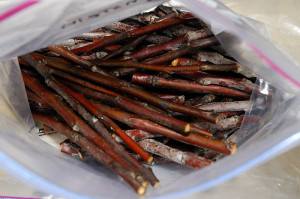
Each cutting, a 6-8 inch length of last season's growth from this Gravenstein, is called a Scion, and every scion is a potential new fruit tree!
What is a Scion Exchange?
Chapters of the California Rare Fruit Growers sponsor annual events called ‘scion exchanges’ each winter. Our local Monterey Bay Chapter of CRFG scion exchange was on Sunday at Cabrillo College’s Horticultural Center. The concept of a scion exchange is simple. In winter, during the period of winter pruning, young scion wood is collected and taken to an exchange event. It’s basically an orchardist’s swap meet.
Why Go To A Scion Exchange?
It’s fun, and a great way to meet others interested in growing a diverse collection of fruit.
Grafting your own fruit trees can be an economical way to start a small orchard. Economics aside, for the average home gardener or small orchardist that is looking to just add a few trees, or graft an additional variety of apple or pear on to an existing tree, the primary reason to attend a scion exchange is for the variety of fruits that are available.
It’s clear here that even though we have many nurseries nearby, most carry the same fruit tree stock, from the same commercial nursery sources. If those commercial nurseries don’t produce a particular variety of interest, it makes finding that fruit almost impossible. That leaves us with a few specialty online nurseries, but that’s still no guarantee, especially if they can’t ship that varietal to your state. That’s where the scion exchange comes in, as it provides access to varieties of fruit that might not otherwise be available in our area.
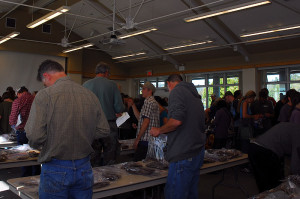
A well attended scion exchange is likely to have a very diverse collection of scion wood to choose from
Preparing for the Event
We’d never attended a scion exchange. We’d hoped to last year, but the orchard wasn’t quite far enough along. We’ve gradually been assembling lists of fruits we’d consider adding to the orchard, so we had an idea what we wanted to look for.
To attend, this scion exchange didn’t require that you bring scions to swap, but we felt that if we could bring something, we should. The broader the selection of available fruit, the more interesting the exchange.
Not all fruit tree varietals are accepted at the exchange, specifically those still under patent. For us only our ‘Flavor King Pluot’ (patent expires in June 2011), and ‘Dapple Dandy Pluot’ (patent expires 2014), are considered to be forbidden fruits for the exchange.
The only non-patented trees that we allowed to fruit at all in 2010 were the ‘Frost Peach’, ‘Flavor Supreme Pluot’, and ‘Blenheim Apricot’. As such, those are the only fruits thus far that we know are true to type. Our Frost Peach was almost completely destroyed by deer last year. Most of the damaged limbs died by mid-summer, and after winter pruning, and removing the dead wood, we opted not to remove any scion wood, for fear we may not have a tree left!
We did collect scion wood from the ‘Flavor Supreme Pluot’, and the ‘Blenheim Apricot’ to take to the exchange though.
For more on collecting scion wood for grafting, this video from the CRFG provides a good overview.
Once we arrived at the scion exchange on Sunday, we were impressed at the sheer variety of fruit available. We specifically were on the lookout for apples, fruiting crab apples, and persimmons for this year, but almost every fruit imaginable was there.
What Do You Do With A Scion?
Browsing the tables, a few varieties of apple caught our eye. However, deciding to obtain a scion for that varietal, means you have to have somewhere to put it! You can’t just plant it, as it has no roots. You either need an existing tree of that type (apple, pear, peach etc.), or you need to acquire the appropriate rootstock to graft your scion on to. Another consideration is whether or not the fruit under consideration needs a pollenizer.
For those that were curious and wanting to graft their own, such as ourselves, demonstrations were provided throughout the event on grafting. Here fellow CRFG member John Valenzuela demonstrates the ‘cleft grafting’ method.
Once grafted, the exposed tip of the scion is sealed with wax, tape or an elastic grafting compound to prevent dessication. The completed graft is then potted into a 1-2 gallon container with potting mix.
Eager to begin grafting, we had a few particular fruit varietals we were looking for. Some we found, some we didn’t, but we certainly didn’t come home empty handed! During this scion exchange we acquired the following fruits:
Apples
Akane: (Self-sterile). Also known as Tokyo Rose, this newer variety is a cross between Jonathan and Worcester Pearmain. Mid-sized red fruits, Akane is reportedly an excellent dessert apple, and also good for drying.
Allen’s Everlasting: (Self-sterile). Russetted dessert apple. Possibly a seedling of Sturmer Pippin from Ireland, introduced in the 19th Century, this apple just swept the Wilder Ranch/CRFG apple tasting this year. An excellent keeper.
Arkansas Black: (Self-sterile) Thought to have been raised by John Crawford in Arkansas in the 1840s. Winesap believed to be one of the parents. Fruits are a very deep dark red in color, the flesh is yellow, and reportedly quite tart when harvested, but mellows in storage. This is an excellent keeping variety, and may store for up to six months in ideal conditions. Used for fresh eating, cooking, baking and cider.
Golden Russet: (Self-Sterile). Considered one of the best heirloom “champagne” cider apples. Golden Russet dates from the mid-1800s, is a fine apple for eating and drying, and makes an excellent sweet juice. Apples are Grey-green to golden bronze with a coppery orange blush. This apple is heavily splotched with light brown russet. The yellow flesh is crisp, highly flavored, with a fine-texture.
Culinary Crab Apples
Humboldt: We’re not absolutely certain of this crab apple’s identity. In the 1940s, noted California pomologist Albert Etter called a seedling of the Transcendent crab apple ‘Jumbo Transcendent’. The California Nursery Company then patented this same fruit under the ‘Humboldt’ name, but apparently never released it to market. Later, a varietal called ‘Emma’, also by Etter, was released under the ‘Humboldt’ name, but subequently thought lost. Whether our crab apple will resemble ‘Emma’, or Etter’s original ‘Jumbo Transcendent’, only time will tell.
Wickson: Another hybrid produced by Albert Etter, and reportedly one of his most popular. This is a cross of ‘Spitzenberg Crab’ and ‘Newton Crab’. Fruits are large, averaging 1.5 to 2 inches in diameter. Reportedly an excellent hard cider apple with a high sugar content, spicy flavor and a pronounced acid tang. Etter strongly recommended this variety for “champagne” cider making.
Persimmons
Izu: The first of the non-astringent Asian persimmons to ripen, ripening approximately 3 weeks before Fuyu. Izu is self-fertile variety, with a cinnamon sweet flavor, and should help to extend our persimmon harvest in fall.
Suruga: Crisp non-astringent variety, and reportedly one of the best tasting persimmons (second perhaps only to ‘Saijo’), ripening from early November to early December. Good for warmer climates.
At the end of the event we purchased five new M-111 semi-dwarfing (85% of full size) apple root-stocks (a mere $3 each) to graft our new apple and crab apple scions to (we’re grafting the persimmon scions to an existing tree). For now those rootstocks are heeled into damp soil in the orchard, and our scions are safely tucked away in the refrigerator, and we’ll leave them there until we’re ready to graft in the next few weeks. The closer to bud break the rootstocks are, the more successful the grafting should be. We’ll post a follow-up as soon as we start to graft our new trees!


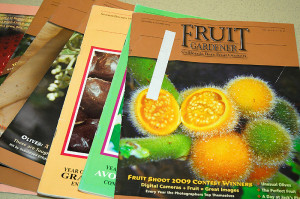
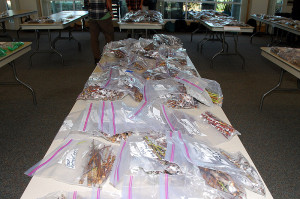
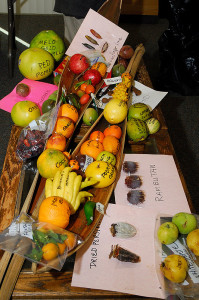
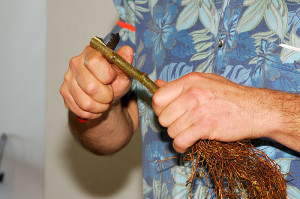
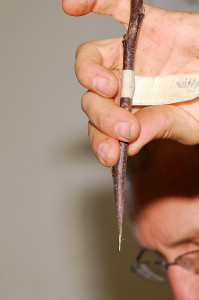
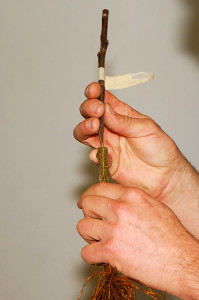
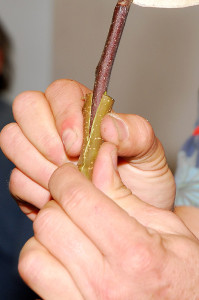
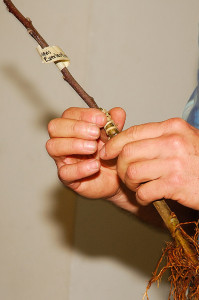
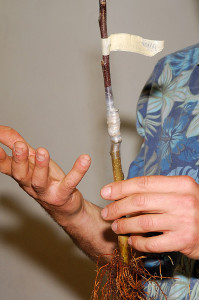

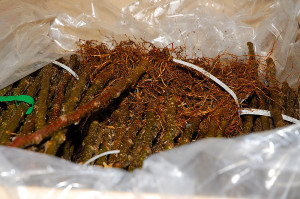







The Golden Gate scion exchange is next weekend, and I’m so uncertain of the etiquette of arriving empty-handed. We have a few fruit trees in our tiny urban garden, but I suspect that they are the “Usual Suspects.” (Meyer lemon, Santa Rosa plum, Fuyu persimmon.) I cannot imagine that anyone would be interested in those types, since you can buy them at the Home Depot.
I’m almost out of this year’s honey, so I really have nothing to share, other than kale leaves, and rosemary. Would it even be polite to bring such things, or should I just go to observe, and not expect to get any scions?
Don’t worry about it at all Lisa. They encourage people who don’t even have fruit trees yet to attend, who are interested in creating their own for their garden. If you’re not a CRFG member, you’ll pay a $5 fee for entry to the event. Take a zip top bag, some masking tape and a pen (so you can label any scions you find). They’ll have plenty I’m sure. We saw lots of Fuyu, and Hachiya persimmon yesterday. Even though they are in the big box stores, ones grown locally are presumed to be better adapted to your area, so people still want them. Sometimes they just need a branch or two to pollinate a self-sterile variety. You can take some if you wish, but there’s certainly no obligation to. The scions we took were quite common too. Our exchange did have apple rootstocks, although I’m not sure if they had rootstocks for pears or persimmon as I wasn’t looking. Of course, figs and pomegranates aren’t grafted, so you wouldn’t need rootstock for those. Just go, and have a blast! 😀
I’m super excited now to go to the exchange in our area on Saturday!!!
You’re going to have so much fun. Helps to take a list, but honestly, once I got there there were so many to choose from, it was almost overwhelming…in a fun sort of way of course 😛
When I saw the title, I thought you were selling your car! HA! Anyway, I think this is Junior year gardening, and I’m still trying to get through the freshman doldrums. Although, it would be nice to have a single tree that contained all the citrus for whatever I might be drinking.
Actually, it’s not difficult at all. If you have one in your area (check the CRFG website), it might be fun to go to an exchange just as an observer in your sophomore year, so when the test rolls around in junior year…you’re ahead of the class 😉 Actually, it’s a great way to learn about varieties you may never have seen or heard of, so when you’re deciding what to plant, you have a better idea of what’s available locally. You can also chat to other fruit growers, and find out which varieties perform the best where you are.
There are some wonderful clubs and events to attend where you live! I’m slightly jealous. That scion exchange sounds like great fun and so interesting to find all those rare varieties of fruit.
We really are fortunate to have so many fun events going on in winter and spring here…except…all these fun events are not helping me get my greenhouse up any faster 😛
This exchange sounds like so much fun. I am learning so much. I say there is no such thing around here but even if there were I wouldn’t have known what it was until now. Can’t wait to see how your new fruit trees will do.
Charlotte, the closest similar group I find to you is the Brevard Rare Fruit Council, headquartered near Palm Bay. See their website at:
http://www.brevardrarefruitcouncil.org/
They also have a Facebook page. They may be able to connect you with some rare fruit growers in your area.
Thanks for the info.
This was a very informative post, Clare. I’ve always been impressed by those people out there who graft their own fruit trees. Sounds like you are going to have an amazing orchard!
We’re going to have a very busy orchard! 😉 The apples won’t fruit for some years, as grafted scions take a while to mature into a productive tree, but once all of our trees are producing, we’re going to have a LOT of fruit!
Clare, this is very interesting and what fun! I need to do this!! Thanks for sharing!
I think you’d have fun with this Carol, you already have some beautiful trees, and lots of space for a few more 😉
You two do the most interesting things! I had never heard of a scion exchange, but what a great idea. I hope your grafts all take and you get lots of fruit in the coming years. We have a 5 way grafted apple tree, one branch is Akane, but the label fell off and I no longer know which is which 🙂
Once your tree is in fruit, there are some good online references with images, I hope you can figure out which is which. I’ve become a big fan of metal labels in the orchard, but also make it a rule to check the condition of the tags each winter during the winter pruning season.
This was interesting about the scion exchange. I never heard of it, but then I do not raise fruit trees. We did learn the process in Master Gardening classes way back. We each did our own and it was a lot of fun watching them take.
I’m looking forward to babying these young trees along, and crossing my fingers they take. Although if one or some should fail, there’s always next year’s scion exchange 🙂
You make grafting seem quite easy! I wish you well with all your scions. I have never heard of a scion exchange; what a great way to get new fruit trees. Having just discovered persimmons, I will be very interested in how your new varieties do. I am surprised there are persimmons reported to have better flavor than fuyu; they must be extraordinary!
It does seem quite straightforward. I’m sure it will take a little practice to perfect the technique, but fortunately scions are plentiful this time of year.
As for persimmons, the Fuyu and Hachiya are popular because they ship well (as fruits). Did you know there are over 500 varieties of persimmon that have been developed? Most of us are familiar with less than half a dozen, and they all have unique characteristics in their fruit. Some even change in flavor and texture if they’re pollinated by other varieties. I think it’s a shame how narrow our fruit selections in our diet have become. I’m looking forward to walking through the orchard and eating fruit can’t find in my local market!
Great account of the Monterey Chapter Scion Exchange. Great detail and photos. I was the fellow doing the bench grafting of apple scions folks selected onto the M111 bare root stock. Sounds like you chose some great varieties. To help folks “Make the Best of the Exchange” the Golden Gate Chapter has posted several documents online, including a list of other exchanges- 4 more exchanges in Northern Cal! Join us in El Sobrante next weekend!
JV-
John, thank you for stopping by! I was the slightly annoying person with the Nikon while you grafting an Allen’s Everlasting for someone 😉 Thank you also for very clear and succinct grafting demonstrations, and for the tips on grafting supplies too! We can’t wait to get started!
I never heard of a scion exchange. I am so glad that events like this our occurring–they must really help to preserve heirloom fruit varieties.
I agree Carolyn, I think as more old orchards are lost to mini-malls and housing developments, events such as these will become even more important for preserving our fruit-growing heritage. So many old varieties have already been lost, I think we should strive to preserve those that remain.
You all are very busy at Curbstone Valley…chickens, grafting, etc. It is all very interesting how grafting works. Enjoyed the post!
Clare you and your husband are always doing something really interesting around the farm. I’ve never heard of this type of exchange before.
There are quite a few types of apples that are more cold tolerant and suit scottish climates but it is so hard to source them as the main nurseries and garden centres seem to source their trees from down south in England. I must make a few enquiries.
I never heard of a scion exchange before, but I have a friend with an antique apple orchard and she has gotten scions from many old farmers. She is a genius at grafting.
Grafting – So magical! Our neighbor grows fruit trees so we don’t have to :-). I remember the first time I walked into my grandfather’s attic and there on the floor were spread out all the Cox’s Orange Pippins he’d harvested and stored up there. They kept for months and just got sweeter – yum, I love that apple!
This is so cool! I keep forgetting that I can graft extra fruit varieties onto my existing trees. I’m very excited about the idea of extra persimmons, pears, and peaches to eat. I don’t think we have an exchange like this near me, though — it looks fantastic! I’ll try searching for one or at least some people willing to trade one on one.
Clare, I know nothing about grafting! But, now I do! What an interesting and informative post. You give the best information and provide super cool photos! I can’t wait to se the follow up posts! gail